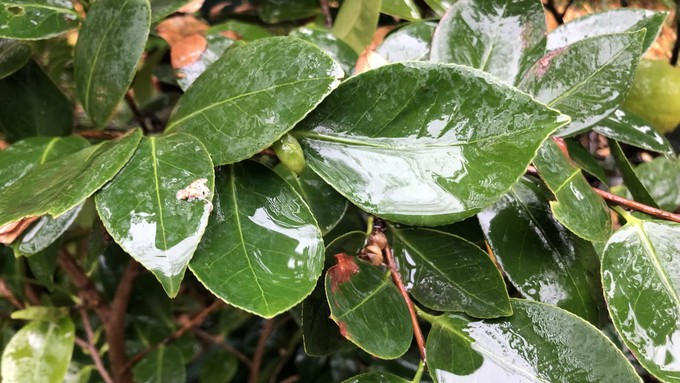
Light rain, cool temperatures and warm soil create great conditions for planting fall garden

The Sacramento area received some light rainfall Saturday morning to end September on a wet note. Kathy Morrison
Surprise! Fall is making a (little) splash with a drizzly weekend.
Sacramento’s last day of September will be unusually cool and possibly wet, says the National Weather Service. Along with a 40% chance of rain, afternoon temperatures will be decidedly cool; Saturday’s expected high is only 68 degrees – 20 degrees below average for this date.
“Scattered showers and isolated thunderstorms are expected to continue today through tomorrow, though the majority of rainfall will occur today,” the NWS Sacramento office tweeted Saturday morning. “Watch out for slick roadways and minor ponding while driving.”
Less than 0.15 inches are expected in downtown Sacramento; north of I-80 likely will get a little more. That’s probably not enough to prompt turning off the sprinklers. Check your soil to see which plants still need a drink.
September ends our “water year” and it’s usually a very dry month. If we do get one-tenth inch of rain, it would push our September rain total to above normal. Before Saturday, September had totaled 0.02; average for the month in Sacramento is 0.08.
Although it feels very fall-ish this weekend, our summer heat isn’t over. Following this cool spell, we’ll have a few days in the mid 80s. Then, the weather service expects Sacramento to return to 90 degrees by Thursday and stay hot through next weekend. That heat may coax a few more tomatoes to ripen and will keep soil warm.
So, make the most of this cooler weather. Get to work on your fall garden:
* October is the best month to plant trees, shrubs and perennials. Plants become established – sending down deep, strong roots – faster in warm soil.
* Divide and replant perennials. Add a little well-aged compost and bone meal to the planting hole, but hold off on other fertilizers until spring. Keep the transplants well-watered (but not wet) for the first month as they become settled.
* Now is the time to plant seeds for many flowers directly into the garden, including cornflower, nasturtium, nigella, poppy, portulaca, sweet pea and stock.
* Plant seeds for radishes, bok choy, mustard, spinach and peas.
* Plant garlic and onions.
* Set out cool-weather bedding plants, including calendula, pansy, snapdragon, primrose and viola.
* Reseed and feed the lawn. Work on bare spots.
* Dig up corms and tubers of gladioli, dahlias and tuberous begonias after the foliage dies. Clean and store in a cool, dry place.
* Treat azaleas, gardenias and camellias with chelated iron if leaves are yellowing between the veins.
* Clean up the summer vegetable garden and compost disease-free foliage.
* Harvest pumpkins and winter squash.
Comments
0 comments have been posted.Sacramento Digs Gardening to your inbox.
Sites We Like
Garden Checklist for week of May 5
Survey your garden after the May 4 rainstorm. Heavy rain and gusty winds can break the neck of large flowers such as roses. Also:
* Keep an eye on new transplants or seedlings; they could take a pounding from the rain.
* Watch out for powdery mildew. Warmth following moist conditions can cause this fungal disease to “bloom,” too. If you see a leaf that looks like it’s dusted with powdered sugar, snip it off.
* After the storm, start setting out tomato transplants, but wait on the peppers and eggplants (they want warmer nights). Pinch off any flowers on new transplants to make them concentrate on establishing roots instead of setting premature fruit.
* Trim dead flowers but not leaves from spring-flowering bulbs such as daffodils and tulips. Those leaves gather energy to create next year's flowers. Also, give the bulbs a fertilizer boost after bloom.
* Pinch chrysanthemums back to 12 inches for fall flowers. Cut old stems to the ground.
* Mulch around plants to conserve moisture and control weeds.
* From seed, plant beans, beets, cantaloupes, carrots, corn, cucumbers, melons, pumpkins, radishes and squash.
* Plant onion sets.
* In the flower garden, plant seeds for asters, cosmos, celosia, marigolds, salvia, sunflowers and zinnias. Transplant petunias, zinnias, geraniums and other summer bloomers.
* Plant perennials and dahlia tubers for summer bloom.
* Don’t wait; plant summer bulbs, such as gladiolus and tuberous begonias.
* Harvest cabbage, lettuce, peas and green onions.